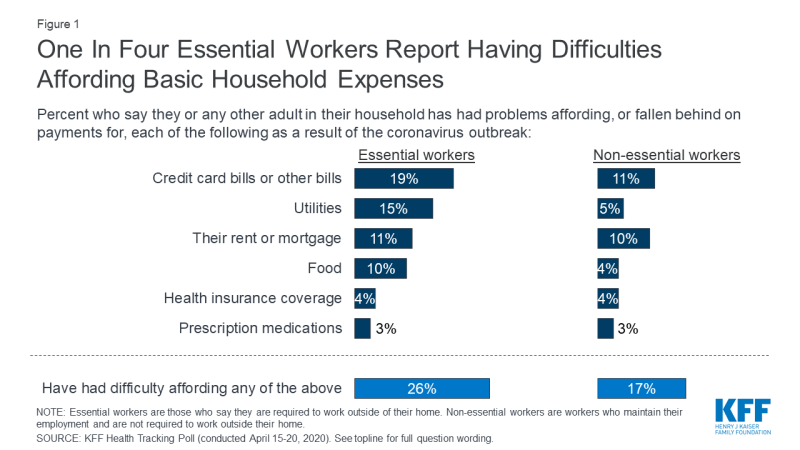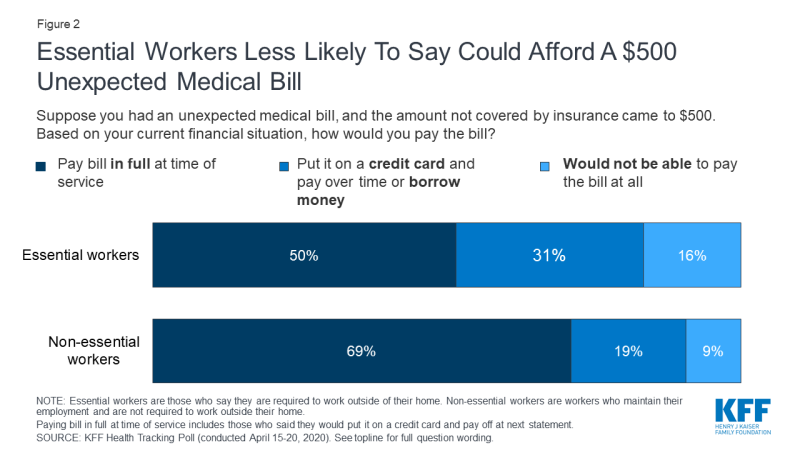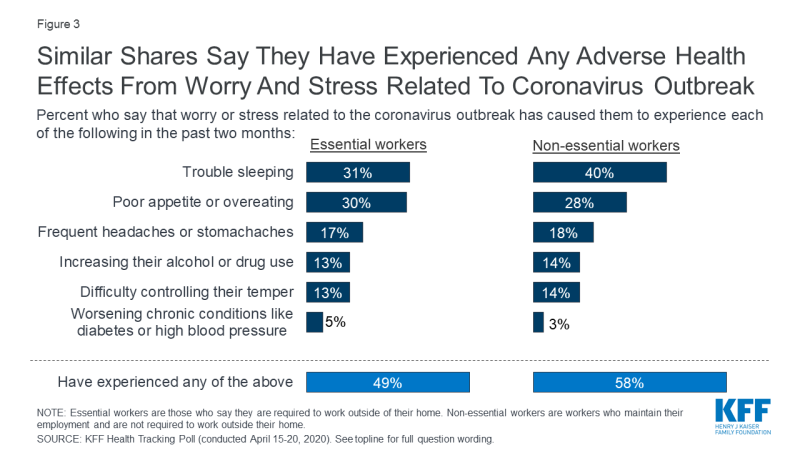Taking Stock of Essential Workers
Audrey Kearney and Cailey Muñana
Published:
The COVID-19 pandemic has changed the reality of working life for most of the U.S. workforce. Whether they find themselves laid off, working from home, or continuing to go to a workplace while taking measures to protect themselves and their families from infection, nearly all workers have felt some form of disruption in their jobs. In this post, we use data from the latest KFF Health Tracking Poll to examine the experiences of essential workers – those who are still required to work outside of their home during the coronavirus outbreak. Since the start of the pandemic, essential workers have been on the front lines making sure that people are able to continue to access their basic needs. While states have determined different criteria for what is deemed an essential business and essential worker, some jobs are universally essential across the country: hospital and health care delivery workers, grocery store clerks, pharmacy and convenience store employees, airline workers, and first responders, to name a few. While most workplaces have put measures in place to protect workers, essential workers still have a higher risk of contracting coronavirus compared to those who are able to stay home. So, who are these essential workers?
One-third (34%) of U.S. adults say they have been deemed an essential worker and are currently working outside their home. Compared to others who are currently employed (most of whom are presumably able to do their jobs from home), essential workers working outside the home are more likely to be Black (15% vs 5%), have a household income of less than $40,000 (31% vs 19%), and a majority (70%) of essential workers do not hold a college degree, while six in ten (61%) non-essential workers have at least a 4-year degree. One-fourth (26%) of essential workers say that they or someone in their family is a health care worker, one classification of employment that has been considered essential across the country.
| Table 1: Demographic Makeup of Essential and Non-Essential Workers | ||
| Currently employed – Essential worker |
Currently employed – Not an essential worker |
|
| Gender | ||
| Male | 58% | 50% |
| Female | 42% | 50% |
| Race/Ethnicity | ||
| White, non-Hispanic | 61% | 72%* |
| Black, non-Hispanic | 15%* | 5% |
| Hispanic | 16% | 11% |
| Household Income | ||
| Less than $40K | 31%* | 19% |
| $40K- <$90K | 35% | 27% |
| $90K or more | 29% | 49%* |
| Education | ||
| High school or less | 35%* | 17% |
| Some college | 35%* | 22% |
| College + | 30% | 61%* |
| Insurance Status | ||
| Insured | 86% | 91% |
| Uninsured | 13% | 8% |
| Do you or anyone in your household work in a health care delivery setting, such as a doctor’s office, clinic, hospital, nursing home, or dentist’s office? | ||
| Yes | 26%* | 8% |
| No | 74% | 92%* |
| NOTE: * indicates a statistically significant difference between columns | ||
Workplaces across the country look very different now than they did just a few months ago, regardless of whether that business or service has been deemed essential or not. While many non-essential workers have been able to adapt to conduct their work online and over the phone, essential places of employment have had to restructure their hours and occupancy to accommodate both the demand of their services and the safety of their workers. Hospitals have also had to reprioritize in order to help care for the influx of possible coronavirus patients. Life has been disrupted for the vast majority of workers, with members of both groups reporting their lives have been disrupted at least some by the pandemic (82% and 90% respectively). Our polling finds that essential workers are more likely than their non-essential counterparts to say that they have had their working hours reduced because of the outbreak (35% vs 24%), while one in five in both groups report experiencing pay cuts (19% of essential workers and 20% of non-essential workers).
| Table 2: The Adapting Work Environment | ||
| Currently employed – Essential worker |
Currently employed – Not an essential worker |
|
| How much, if at all, has your life been disrupted by the coronavirus outbreak? | ||
| “A lot” or ”some” | 82% | 90%* |
| “Just a little” or “not at all” | 18%* | 10% |
| Have you had your work hours reduced or limited due to the coronavirus outbreak, or not? | ||
| Yes | 35%* | 24% |
| No | 65% | 76%* |
| Have you had to take a pay cut or had your income or salary reduced because of the coronavirus outbreak, or not? | ||
| Yes | 19% | 20% |
| No | 81% | 79% |
| NOTE: * indicates a statistically significant difference between columns | ||
In addition to being more likely to live in lower-income households, essential workers also report experiencing a heavier financial burden due to the coronavirus pandemic. Essential workers report having more difficulty affording necessities, such as credit card bills (19% vs 11%), utilities (15% vs 5%), and food (10% vs 4%), and are also more likely to say they are “very worried” or “somewhat worried” about affording food (24% vs 12%) specifically because of the crisis.

Figure 1: One In Four Essential Workers Report Having Difficulties Affording Basic Household Expenses
Essential workers working outside their homes may have an elevated risk of contracting coronavirus, and by extension, an increased risk of incurring expenses related to coronavirus treatment. Yet this group is less likely to have the financial resources to pay an unexpected medical bill without going into debt. When asked how they would pay for an unexpected $500 medical bill, a larger share of essential workers say they would have to borrow money to pay back the bill (31% compared to 19% of currently employed non-essential workers) or say they would not be able to pay the bill at all (16% vs 9%).
Furthermore, as some of the most vulnerable members of the workforce, essential workers are experiencing the pandemic up-close and personal. KFF polling finds at least three in ten workers—both essential and non-essential—report knowing someone who has tested positive for the coronavirus (33% and 30% respectively). However, a larger share of essential workers say they know someone who has died from complications related to coronavirus (13% vs 6%).
Despite being more likely to report financial challenges and knowing someone who has died from the virus, essential workers are no more likely than non-essential workers to report any adverse effects on their mental health and well-being due to the pandemic. About half of essential workers (49%) and a statistically similar share of non-essential workers (58%) say the coronavirus outbreak has caused them to experience at least one negative effect, including trouble sleeping, appetite problems, increased alcohol or drug use, or worsening chronic health problems.


